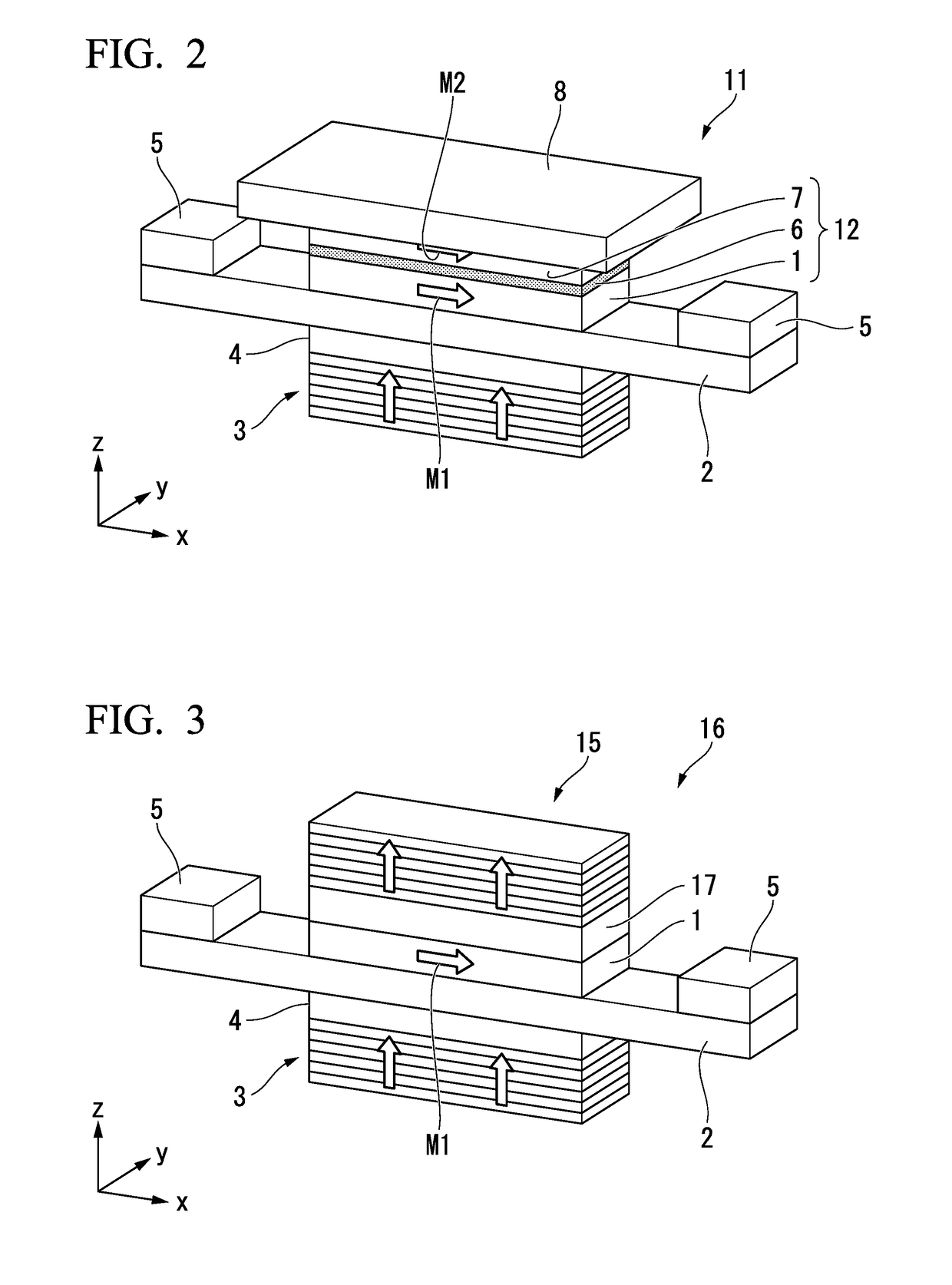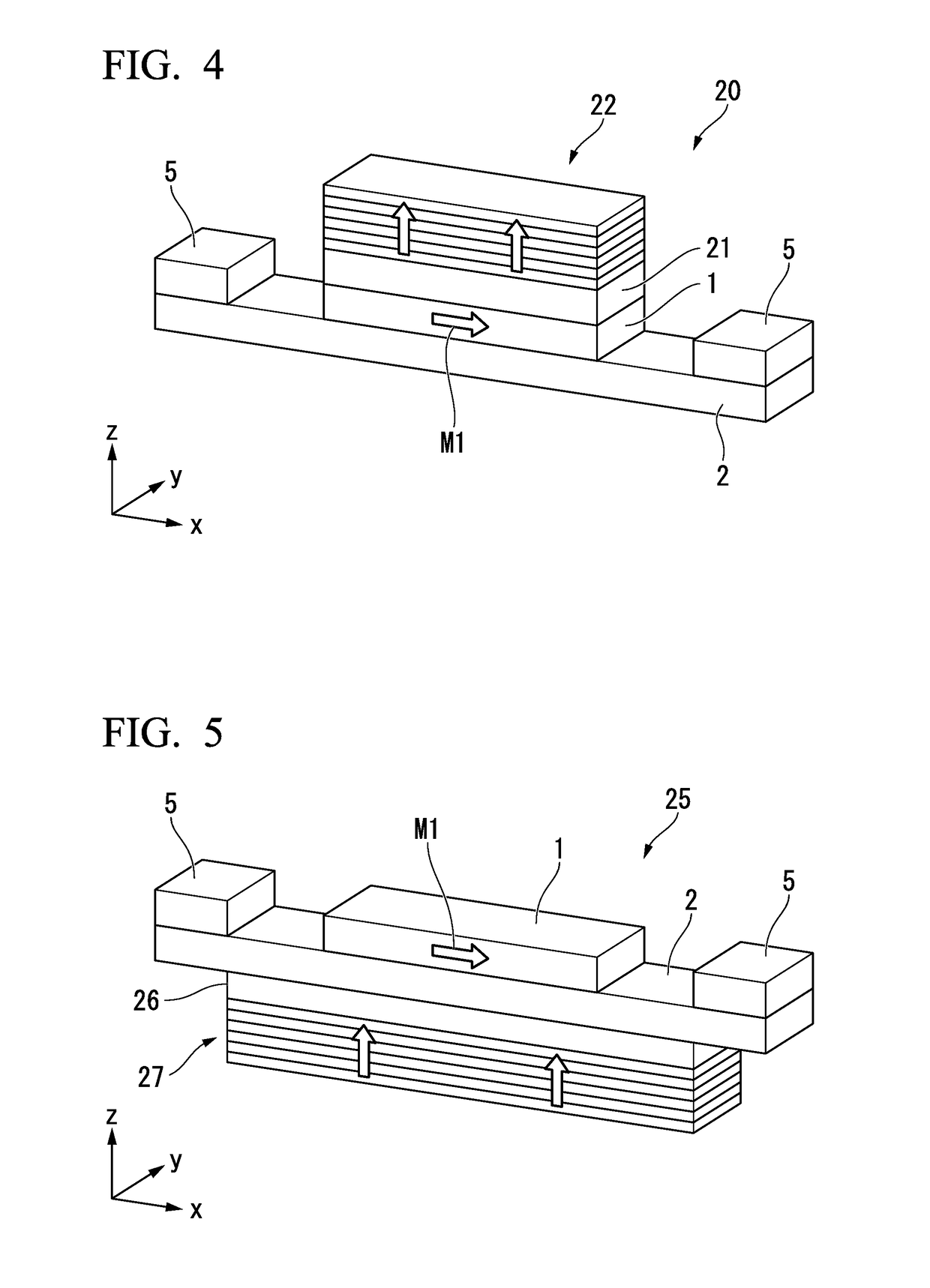Spin current magnetization rotational element, magnetoresistance effect element, magnetic memory, and high-frequency magnetic element
a technology of spin current magnetization and rotational elements, which is applied in the direction of magnetization rotational elements, instruments, and substrates/intermediate layers, etc., can solve the problems of deterioration in degree of integration of integrated circuits, and high rotational current density required to cause magnetization rotation, so as to achieve the effect of not causing deterioration in degree of integration and not increasing the consumption of electricity
- Summary
- Abstract
- Description
- Claims
- Application Information
AI Technical Summary
Benefits of technology
Problems solved by technology
Method used
Image
Examples
first embodiment
[0045]FIG. 1 is a perspective view schematically illustrating a spin current magnetization rotational element according to a first embodiment.
[0046]A spin current magnetization rotational element 10 according to the first embodiment has a first ferromagnetic layer 1, a spin-orbit torque wiring 2, and a first perpendicular magnetic field applying layer 3. In the form of FIG. 1, the first ferromagnetic layer 1 having a rectangular shape in a plan view and having the same width as the spin-orbit torque wiring 2 is laminated on a middle part on an upper surface of the belt-shaped spin-orbit torque wiring 2. The first perpendicular magnetic field applying layer 3 is formed via an insulating layer 4 on a middle side on a lower surface of the spin-orbit torque wiring 2. In addition, electrode layers 5 are formed at both end parts on the upper surface of the spin-orbit torque wiring 2. In the form of FIG. 1, the first perpendicular magnetic field applying layer 3 is formed to have a width a...
second embodiment
[0091]
[0092]FIG. 2 illustrates a second embodiment configuring a magnetoresistance effect element 11 by using the spin current magnetization rotational element 10 of the first embodiment. The magnetoresistance effect element 11 includes a nonmagnetic layer 6 which is laminated above (z-direction) the first ferromagnetic layer 1, and a second ferromagnetic layer 7 which is laminated above (z-direction) the nonmagnetic layer 6. An electrode layer 8 is provided above the second ferromagnetic layer 7. Other configurations are equal to those of the spin current magnetization rotational element 10 of the first embodiment. The magnetoresistance effect element 11 has the first ferromagnetic layer 1, the spin-orbit torque wiring 2, the first perpendicular magnetic field applying layer 3, the insulating layer 4, and the electrode layers 5. In the magnetoresistance effect element 11, a magnetoresistance effect element core unit 12 is constituted of a laminated body including the first ferromag...
third embodiment
[0108]FIG. 3 illustrates a spin current magnetization rotational element 16 of a third embodiment having a configuration in which a second perpendicular magnetic field applying layer 15 is provided in the spin current magnetization rotational element 10 according to the first embodiment and a perpendicular magnetic field applied to the first ferromagnetic layer 1 is uniformized.
[0109]The structure of the third embodiment is characterized in that the second perpendicular magnetic field applying layer 15 is provided above (z-direction) the first ferromagnetic layer 1 via an insulating layer 17.
[0110]Other portions in the structure are equal to those in the structure of the first embodiment. The spin current magnetization rotational element 16 has the first ferromagnetic layer 1, the spin-orbit torque wiring 2, the first perpendicular magnetic field applying layer 3, the insulating layer 4, and the electrode layers 5.
[0111]The second perpendicular magnetic field applying layer 15 is co...
PUM
| Property | Measurement | Unit |
|---|---|---|
| atomic number | aaaaa | aaaaa |
| atomic number | aaaaa | aaaaa |
| spin diffusion length | aaaaa | aaaaa |
Abstract
Description
Claims
Application Information
 Login to View More
Login to View More - R&D
- Intellectual Property
- Life Sciences
- Materials
- Tech Scout
- Unparalleled Data Quality
- Higher Quality Content
- 60% Fewer Hallucinations
Browse by: Latest US Patents, China's latest patents, Technical Efficacy Thesaurus, Application Domain, Technology Topic, Popular Technical Reports.
© 2025 PatSnap. All rights reserved.Legal|Privacy policy|Modern Slavery Act Transparency Statement|Sitemap|About US| Contact US: help@patsnap.com



